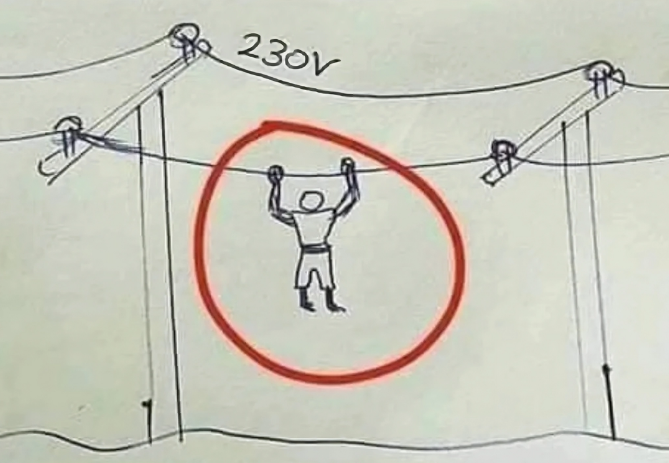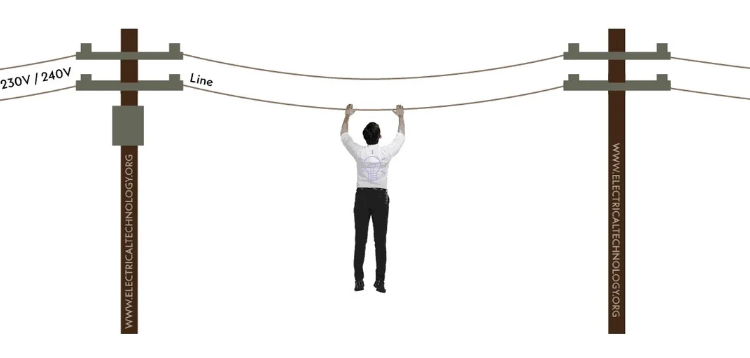Ever wondered why birds can sit peacefully on power lines without a single feather getting ruffled by an electric shock? It’s a fascinating question, especially when you think about how dangerous electricity can be. This article explores whether a person, hanging onto a live wire with both hands, would get shocked or not. Let’s dive into the science of electricity to find out what really happens.
Understanding How Electricity Flows

To understand why touching a live wire might—or might not—shock you, it’s essential to know how electricity works. Electricity flows through materials that conduct it, creating a path or circuit for the current to follow. For an electric shock to occur, electricity must flow through your body, entering at one point and exiting through another, typically the ground or another wire.
Electricity, like water, follows the path of least resistance. This is why birds can sit on power lines without harm; they don’t create a path to the ground, so the electricity has no reason to flow through them. The same principle can apply to humans in specific circumstances.
Why Birds Don’t Get Shocked on Power Lines
Birds can perch on power lines without getting zapped because they aren’t grounded. They only touch the live wire, which means there’s no route for the current to travel from their bodies to the ground or another wire. Without a complete circuit, electricity doesn’t flow through them.
Similarly, if a person grabs a live wire with both hands without touching the ground or any other conductive surface, they won’t create a complete circuit. In theory, this person wouldn’t get shocked because the electricity has nowhere else to go—it simply stays in the wire.
Can a Person Really Hang from a Live Wire Safely?
While it might be theoretically possible, touching a live wire is incredibly risky, even if you’re not grounded. The human body conducts electricity well, and any slight mistake, such as touching something else conductive, could complete the circuit and result in a potentially fatal shock.
Electricity is unpredictable, and even small shifts in position or environmental factors could drastically change the outcome. Power lines carry high voltages that can easily leap or “arc” to nearby objects, which means a close encounter is still dangerous even if you’re not directly touching anything but the wire.
What Happens if You Touch Another Wire or the Ground?
The real danger arises when a person holding a live wire comes into contact with another conductive surface. The moment you touch the ground, a tree, or another wire, you create a pathway for electricity to flow through your body, and this can lead to severe injury or death. Even a slight movement can bridge the gap, closing the circuit and letting the current flow through your body to the ground.
Electricity doesn’t just flow; it rushes. When a complete path is available, high-voltage currents surge through it, causing severe burns, muscle contractions, and even heart failure. That’s why safety experts stress that it’s never safe to handle live wires, no matter how careful you think you can be.
Why Electricians Use Special Precautions

Electricians are trained to handle live wires safely, but they never take unnecessary risks. They use insulated gloves, specialized tools, and maintain safe distances from high-voltage sources to prevent any chance of electric shock. Even though they understand electricity well, they never assume a live wire is safe to touch without precautions.
Electricians often work with “lockout/tagout” procedures, which ensure that power sources are shut off and tagged before work begins. This keeps the workspace safe and ensures no accidental contact with live currents.
Understanding the High Risks Involved
While it might sound fascinating to think you could theoretically hang from a live wire without getting hurt, real life isn’t that simple. The sheer power and unpredictability of electricity make this an extremely dangerous situation. Even a minor mistake can turn a seemingly safe action into a life-threatening event.
High-voltage power lines can carry up to hundreds of thousands of volts, which is enough to cause instant fatality in most cases. And even if you’re lucky enough to avoid immediate danger, the after-effects of a high-voltage shock can include severe tissue damage, internal burns, and other long-term health impacts.
The Bottom Line: Never Risk Contact with Live Electrical Wires
Electricity isn’t something to take lightly, and live wires are best left alone. While birds and squirrels may have a safe time hanging on power lines, humans are far more vulnerable to electric shocks. Even trained professionals handle live wires with extreme caution, using every safety tool available to them.
So, while you might not get shocked if you hang onto a live wire without touching anything else, the odds are stacked against you. Safety around electricity is a must; there’s no room for experimentation when lives are on the line. Remember, the best way to avoid an electric shock is to avoid live wires altogether.
Conclusion
In summary, if a person hangs from a live wire without touching anything else, they may theoretically avoid a shock because they’re not creating a circuit. However, this situation is highly dangerous and should never be attempted. Electricity flows through the path of least resistance, and even a minor contact with another conductive material can create a deadly pathway through the body. Electrical safety is paramount, and it’s essential to avoid live wires at all costs. The next time you see a bird on a power line, remember it’s best to admire from afar—no matter how curious you may feel about hanging from a wire yourself.


